
The Great Northern Railway V class steam locomotives were 4-4-0 three-cylinder compound locomotives built in 1932 by Beyer, Peacock & Company for the Great Northern Railway (Ireland).

The GWR 4100 Class was a class of steam locomotives in the Great Western Railway (GWR) of the United Kingdom.

The Great Western Railway 3252 or Duke Class were 4-4-0 steam locomotives with outside frames and parallel domed boilers. They were built in five batches between 1895 and 1899 for express passenger train work in Devon and Cornwall. William Dean was their designer, possibly with the collaboration of his assistant, George Jackson Churchward. Four prototype 4-4-0s, of the Armstrong Class, had already been built in 1894.
The Great Western Railway 3800 Class, also known as the County Class, were a class of 4-4-0 steam locomotives for express passenger train work introduced in 1904 in a batch of ten. Two more batches followed in 1906 and 1912 with minor differences. They were designed by George Jackson Churchward, who used standard components to produce a four-coupled version of his Saint Class 4-6-0s.

The Lancashire and Yorkshire Railway Class 27 is a class of 0-6-0 steam locomotive designed for freight work on the Lancashire and Yorkshire Railway (L&YR).
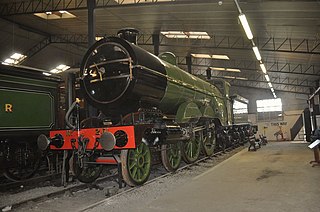
The Great Northern Railway (GNR) Class C1 is a type of 4-4-2 steam locomotive. One, ex GNR 251, survives in preservation. Much like their small boiler cousins, they were capable of reaching speeds of up to 90 mph (145 km/h). They were also known as Large Atlantics.

The Great Northern Railway (Ireland) class S was a class of five 4-4-0 steam locomotive that the Great Northern Railway introduced in 1913 to haul Belfast – Dublin express passenger trains. They were followed two years later by the three similar class S2 locomotives.
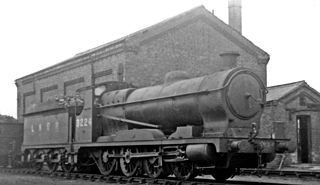
The Great Central Railway (GCR) Class 8A was a class of 0-8-0 steam locomotive built between 1902 and 1911 for handling heavy coal trains over the Pennines. They all passed to the LNER in 1923, who redesignated them Class Q4. They were withdrawn from service between 1934 and 1951.

The GNR(I) class U was a class of 4-4-0 steam locomotives built for the Great Northern Railway (Ireland).

The South African Railways Class 19D 4-8-2 of 1937 was a steam locomotive.
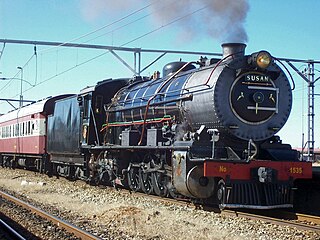
The South African Railways Class 12A 4-8-2 of 1919 was a steam locomotive.
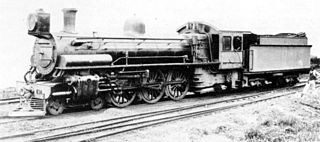
The South African Railways Class 10B 4-6-2 of 1910 was a steam locomotive from the pre-Union era in Transvaal.

The South African Railways Class 10A 4-6-2 of 1910 was a steam locomotive from the pre-Union era in Transvaal.
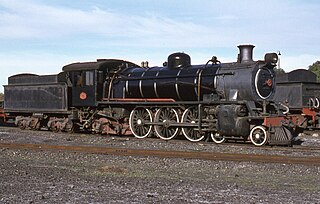
The South African Railways Class 5 4-6-2 of 1912 was a steam locomotive.

The South African Railways Class 3 4-8-2 of 1909 was a steam locomotive from the pre-Union era in the Colony of Natal.

The ČSD Class 387.0 were 4-6-2 express passenger steam locomotives operated by the Czechoslovak State Railways between 1926 and 1974. Forty-three of these 2,100-horsepower (1,570 kW) pacific locomotives were built by the Škoda Works, Plzeň in five series between 1926 and 1937, intended for the heaviest long-distance express trains.
The GS&WR 400 class or CIE class B2/B2a were a class of ten 4-6-0 steam locomotives built for the Great Southern & Western Railway (GS&WR) between 1916 and 1923 for express passenger duties on the Dublin to Cork main line. They proved initially unreliable but rebuilds from four to two cylinders between 1927 and 1937 for the seven survivors produced locomotives yielding satisfactory performance with the last two being withdrawn in 1961.
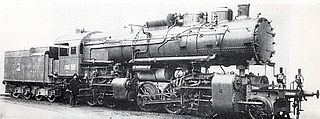
The MÁV class 601 was a class of Hungarian four-cylinder Mallet locomotives, which was designed to haul long and very heavy cargo on very steep railway tracks. At 22.5 m long and outputting 2,200 kW (3,000 hp), they were the largest and most powerful steam locomotives built in Europe before and during World War I.
The Great Southern and Western Railway (GS&WR) Class 351 initially consisted of four 0-6-0 tender locomotives designed by Robert Coey for use on heavy freight trains on the main line. They were joined by four similar locomotives built in 1912 introduced by Richard Maunsell, these had detail differences such as larger cabs and higher running plates. They included an extended smokebox to which a Phoenix superheater was briefly trialed but abandoned. They were initially designated GS&WR Class 249 but were subsequently grouped into class 351.
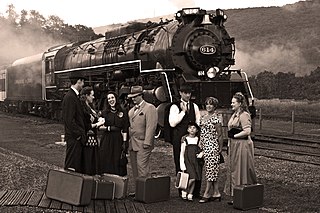
The Chesapeake and Ohio Greenbrier was a class of 12 4-8-4 "Greenbrier" type steam locomotives built by the Lima Locomotive Works between 1935 and 1948 and operated by the C&O. Like a handful of railroads, the C&O didn't name their 4-8-4s "Northerns", and instead went with the name "Greenbrier" after the Greenbrier Hotel in White Sulphur Springs, West Virginia, a major resort on the C&O mainline.

















